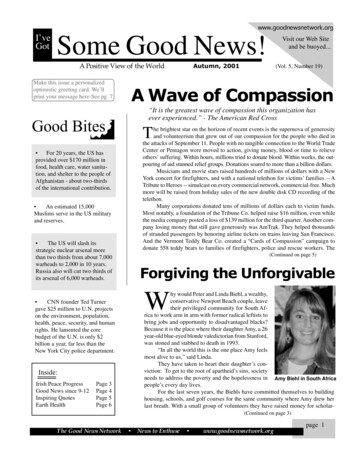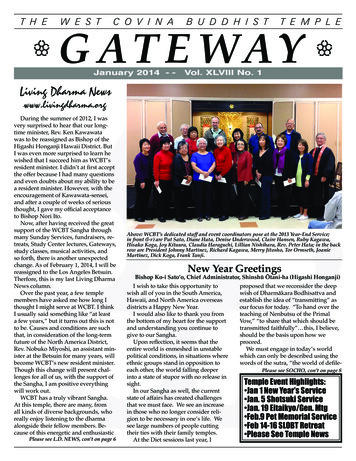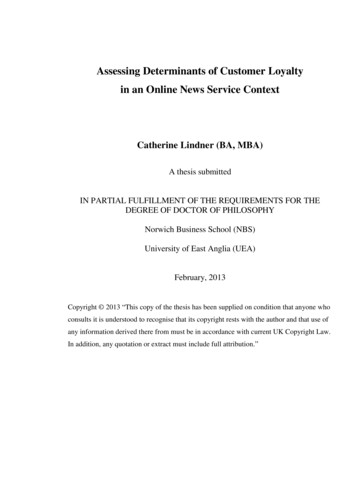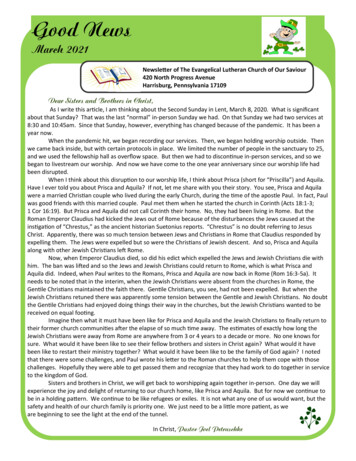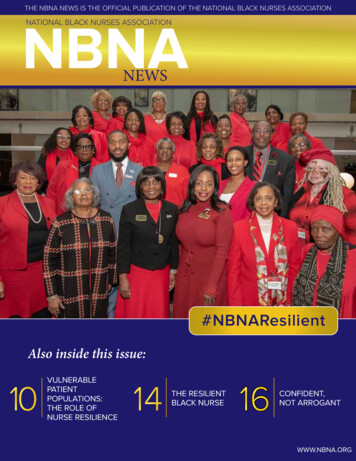
Transcription
THE NBNA NEWS IS THE OFFICIAL PUBLICATION OF THE NATIONAL BLACK NURSES ASSOCIATIONNBNANATIONAL BLACK NURSES ASSOCIATIONNEWS#NBNAResilientAlso inside this issue:10VULNERABLEPATIENTPOPULATIONS:THE ROLE OFNURSE RESILIENCE14THE RESILIENTBLACK NURSE16CONFIDENT,NOT ARROGANTWWW.NBNA.ORG
F E AT U R E SNBNA President’s Letter46Cleveland Council of Black NursesTravel to Washington, DC for NBNA Day on Capitol Hill9Letter From the Co-Editor-in-ChiefVulnerable Patient Populations:The Role of Nurse ResilienceNurse ResilienceThe Resilient Black NurseConfident, Not ArrogantThe Principles of Resilience: How Mental Life is CreatedRemaining Resilient Amid Disruptions in the Nursing FieldPromoting Resilience: A Much Needed Wellness Eventfor our Clinical LeadersRediscovering a Better You: A Nurture the Nurse RetreatON TH ECOVER1012141618202124Dr . Martha A. Dawson, NBNA President with NBNA Chapter PresidentsDr. Julius JohnsonEllen DurantDr. Birthale ArchieDr. Mary KellyRose Ellington-MurrayCynthia BellDr. Carol Jenkins-NeilDr. LaTonya MartinMarchelle BoydVaple RobinsonLois GreeneDr. Pier BroadnaxD eborahMeseret HailuTamara BroadnaxThedford-ZimmermanMonica HarmonRosa CambridgeDr. Patrise TysonThomas HillKim CartwrightJacquelin WinstonFlorence JohnsonYvette ConyersTammy WoodsMarilyn JohnsonSasha DuBoisNBNA NEWSThe NBNA News is printed quarterly; please contact the National Office for publication dates.NBNA News 8630 Fenton Street, Suite 910 Silver Spring, MD 20910 www.NBNA.orgMillicent Gorham, PhD (Hon), MBA, FAAN, Editor-in Chief.Jennifer Coleman, PhD, RN, CNE, COI, Co-Editor-in Chief.22NBNA.org
F E AT U R E S(continued)Supporting Black MamasNurses, Nutrition, and New Value-based Care OpportunitiesSpirituality in Substance Abuse TreatmentEntrepreneurial as a Legal Nurse Consultant:The Basics for SuccessNBNA Partners with the NIH All of Us Research ProgramNational Black Nurses Association: Nurses,Stay Involved and Stay Connected (#NSISC)Chapter Development: “We’re in this Together!”Mentorship is a Two-way StreetGetting Involved with the U.S. 2020 CensusComing Soon – National Black Nurses AssociationMembership Toolkit33353738394143The Program Committee45National Black Nurses Association and AmericanRed Cross: “A Reciprocal RelationshipThat Supports Diversity & Inclusion”47Members on the MoveChapters on the MoveNBNA Day on Capitol Hill 2020NBNA Corporate RoundtableNBNA Chapter Presidents326283250515667713NBNA.org
A Message from the Co-Editor-in-ChiefLetter From the PresidentNursing ResilienceWelcome to 2020 and the Year of the Nurse! Thisnew decade is an amazing opportunity to pauseand reflect on your nursing journey. Some of youare seasoned professionals, and others may be atthe beginning of your careers. No matter whereyou are on the nursing continuum, each of you islikely to be aware of barriers and challenges thatmay have occurred along the way. Some challengesmay have seemed insurmountable at the time;maybe you were not sure you would prevail. Howdid you overcome the challenges? What helped youto achieve your desired result? What is it that empowers an individual to persevere andovercome adversity when pursuing a goal? In your everyday nursing journey, how do youcontinue to do what you do?I submit that the key to your enduring strength is resilience. Resilience may be defined asthe ability to adapt well to difficult events. It is the ability to bounce back when setbacksoccur. To be resilient is to be hopeful, to learn from experience, to have a positive attitude,and to remain focused.I believe the ability to possess and demonstrate resilience is crucial for our current andfuture nurse leaders. Take a moment and consider our current nursing students whoare our future leaders. The rigors of nursing school can contribute to feelings of loss ofcontrol and an inability to cope. If students are to succeed and complete their academicprograms, a proactive, confident outlook is critical.My local chapter manages a nursing student mentorship program where we focus onacademic and emotional support and socialization into the nursing profession. One ofour aims is to provide students with the strategies and tools needed to respond positivelywhen adversity and stress occur. We strive to foster strategies for dealing with challengesand difficulties. We believe that successful management of adverse events is directlyrelated to one’s ability to cope and recover. Consequently, we encourage our nursingstudent mentees to cultivate the attitude and perspective that one stumble along thenursing school path is not a fatal, irreversible step. During a recent mentorship meeting,some of our nursing students shared their strategies for building resilience. They focuson staying organized, letting go of distracting activities, and reminding themselves thatthey are deserving of success. One stated, “I look at others who are successful, and saywhy not me, too?” A nurse leader that I know shared her belief that to be resilient is to beknowledgeable, confident, and bold.Recently, a colleague shared with me a video that was published by Catholic ReliefServices. The video highlights the importance of support for children who have sufferedupheaval and stressful events. The video reminds us that to foster resilience, varied typesof support are needed. When an individual is in the midst of conflict or crisis, attention tophysical, social, and psychosocial needs can strengthen emotional health and the abilityto cope.NBNA NATIONAL OFFICE STAFF:Dr. Millicent GorhamExecutive Director / Editor-in-ChiefDianne ManceConference Services ManagerEstella A. LazenbyMembership Services ManagerTracy RuddAdministrative AssistantKeisha RicksCommunications / Marketing Services ManagerBOARD OF DIRECTORS:Dr. Martha A. DawsonPresident, Birmingham, ALLola Denise Jefferson1st Vice President, Houston, TXPatricia Carter Lane2nd Vice President, Richmond, VASasha DuBoisSecretary, Boston, MATrilby Barnes-GreenTreasurer, New Orleans, LADr. Eric J. WilliamsImmediate Past President, Los Angeles, CADr. Lovene KnightParliamentarian, Los Angeles, CACynthia BellHistorian, Akron, OHDr. Chris BryantEastern Colorado BNA, Denver, CODiamond CummingsStudent RepresentativeNew Orleans BNA, New Orleans, LADr. Sheldon FieldsGreater New York City BNA, Hollis, NYDr. C. Alicia GeorgesEx-Officio, New York BNA, Bronx, NYDr. Shirley Evers-ManlyCouncil of Black Nurses, Los Angeles,Los Angeles, CADr. Rebecca Harris-SmithAcadiana BNA, New Orleans, LAThomas HillNew Jersey Integrated BNA, Plainfield, NJDr. Marcia LoweBirmingham BNA, Birmingham, ALSabrina NewtonGreater New York City BNA, Jamaica, NYKim ScottBay Area BNA, Oakland, CADr. Katherine TuckerNorthern CT BNA, New Haven, CTDr. Millicent GorhamExecutive DirectorWhat are your thoughts on resilience? How can you strengthen your personal resilienceand that of your patients and colleagues?44NBNANBNA WinterWinter 2020Issue
A Message from the Co-Editor-in-ChiefLetter From the PresidentIn this issue of NBNA News we examine the concept of resilience, and provide suggestions for recognizing and promoting resilience. Thefuture of nursing depends upon our success as each of us accepts the challenge to learn from experience and to maintain a focused andhopeful perspective.Jennifer J. Coleman, PhD, RN, CNE, COICo-Editor-in-ChiefBirmingham Black Nurses AssociationHistory SpeaksNBNA Presidents’ SpotlightThe National Black Nurses Association (NBNA) was organized in1971 to provide recognition of Black nurses and to influence healthcare services for Black people by increasing attention to the healthneeds of Black people. While many Black nurses were membersof the American Nurses Association (ANA), nurses of color hadlittle influence on the ANA’s issues and leadership. NBNA foundersbegan with the philosophy that optimal health is a right of everyAmerican citizen. In the 1960s and 1970s minority Americans wereoften neglected and excluded from the means to enjoy optimalhealth. NBNA’s goal to investigate, define, and determine what thehealth care needs of Black Americans are, and to implement changeto make available to Black Americans and other minorities healthcare commensurate to that of the larger society is the foundationof the organization.Recognizing that a major concern was to increase the number ofBlack nurses in the country, the founders believed that incorporatingall levels of Black nurses into the organization would place themin a better position to influence all nursing education programs inwhich Black students were enrolled, as well as the caliber of allnursing services provided to Black consumers. Therefore, fromthe very beginning, membership was open to registered nurses,licensed vocational/practical nurses, and nursing students.During the organization of NBNA, founding members also pushedfor greater representation in ANA. In 1972 the Affirmative ActionTask Force at ANA, including several of our founders, sought toensure representation and participation of minority nurses in allANA programs.5Today, NBNA’s mission remains unchanged: to serve as thevoice for Black nurses and diverse populations ensuring equalaccess to professional development, promoting educationalopportunities, and improving health. NBNA represents AfricanAmerican nurses and nursing students from the U. S., EasternCaribbean, and Africa. NBNA’s signature programs and itscollaborative partnerships provide a forum for varied communitybased health programs.(information from www.nbna.org/history)First President - Lauranne SamsDr. Lauranne Sams was one of the organizers and cofounders ofNBNA. She chaired the steering committee that began the initialsteps to form the organization and became its first president in 1971.She joined the faculty of Indiana University in 1958 as its first AfricanAmerican faculty member and earned her doctorate in educationalpsychology at Indiana University in 1968. In 1974 Dr. Sams acceptedan appointment as nursing dean of then Tuskegee Institute inTuskegee, Alabama.The Davis-Sams Distinguished Visiting Professorship at IndianaUniversity was established in 1999 to provide an opportunity fora distinguished leader in nursing to spend a week consultingwith faculty, lecturing to students, and engaging with the largercommunity. The annual Dr. Lauranne Sams Scholarship, sponsoredby NBNA, provides funding for nursing students to continue theireducation.5NBNA WinterNBNA.orgIssue
Letter From the President2020 Year ofthe Nurse andMidwife: FebruaryBlack HistoryMonth and MarchNational Women’sHistory MonthMartha A. Dawson, DNP, RN, FACHEPresident, National Black Nurses AssociationUnlike every other discipline or profession, the storiesand history of African American (AA) nurses are rarely,if ever, mentioned in history books or in nursingtextbooks. Recently, I was invited by the Lexington BlackNurses Association to speak at their annual scholarship dinner.The theme was “Hidden Figures Among Us”. Using this theme tocreate talking points developed into a mental walk down a pathwayfilled with a rich history of where AA nurses started, roads we havetraveled, and destinations we have yet to reach. As we celebrate“2020 the Year of the Nurse and Midwife”, I encourage nurses ofdifferent races and ethnicities to learn and appreciate their history(our story). Get to know your “hidden figures” and their contributionsto the profession of nursing. Many of these outstanding women andmen have worked to improve the health of our nation and the world.As the profession celebrates Florence Nightingale’s 200thbirthday, AA nurses should include in their celebrations andacknowledgements Isabelle Baumfree (Sojourner Truth) and MarySeacole. In 1797, Ms. Sojourner Truth was born a slave. She is best6known for her work as a woman activist and abolitionist. However,Sojourner was a nurse who worked for the Dumont family. Shealso worked for the National Freedman’s Relief Association inWashington, DC. Similar to Nightingale, Ms. Truth advocated forcleanliness and quality of care. One of her many contributions tonursing was urging Congress to finance nursing education.Nurse Mary Seacole was born in 1853, and her service during theCrimean War rivaled that of Nightingale. After being denied theopportunity to work alongside others to care for soldiers, Seacoleentered the war zone and not only provided care to wounded men,but she built a “hotel” to house them. Today in Britain, there arescholarships, organizations, and buildings named in her honor.AA nurses played a significant role during the American Civil Warand during the smallpox pandemic in the 19th century. HarrietTubman provided care to solders with dysentery and smallpoxusing traditional, herbal remedies. A Union general petitionedCongress to provide Tubman a pension for her outstanding work.As she continued as a nurse, later in life Nurse Tubman becamean entrepreneur and founded a home for the elderly. Our history isrich with nurses who focused on human caring, Mary Eliza Mahoneyworked as washwoman, maid, and cook; and yet she becamethe first AA registered nurse in the United States. She was oneof three students out of 40 that completed the nursing programat the New England Hospital for Women and Children in Roxbury,Massachusetts (1879). In 1908, she was a co-founder of the NationalAssociation of Colored Graduate Nurses.NBNA WinterNBNA.orgIssue
Letter From the PresidentMy search for the first AA male nurse was not easy, and thetruth is I am not sure that my findings are accurate due to thehistorical practice and failure to record information about AAaccomplishments. Nevertheless, James Derham (Durham), a slavewho was moved between multiple masters, purchased his freedomin 1783 by working as a nurse and opened his medical practice.Again, the evidence is inconsistent. In some sources, Derham isconsidered to be the first AA physician in the U.S. and in otherdocumentation, he is listed as the third. However, to be sure thathistory is better today, I researched one of NBNA’s own members:Randolph Rasch, PhD., RN. Dr. Rasch is the first AA male nurse toearn a PhD. He has more than 25 years of experience in highereducation and as a researcher. He is recognized for his role as partof the team that developed a health care system in the TennesseeDepartment of Corrections where he served as one of the firstnurse practitioners. Dr. Rasch is dean of nursing at Michigan StateUniversity.There are so many firsts for NBNA members. In 1968-69, leadersfrom Los Angeles (Betty Smith Williams and Barbara Johnson) andFlorence A. Stroud and Carlessia Hussein of San Francisco plannedand held a statewide conference that attracted Black nurses from asfar away as Miami and New York. From this conference a movementwas started, a better future was envisioned, and the momentumof this group continued at the 47th convention of the AmericanNurses Association (ANA) in Miami, Florida in 1970. Like-minded AAnurse leaders caucused to discuss the lack of their inclusion andpresence in the leadership of ANA. This caucus session resulted inthe establishment of a steering committee chaired by Dr. LauranneSams. On December 18-19, 18 Black nurses from across the countrymet in Cleveland, Ohio at the home of Dr. Mary Harper. These nursescreated the premier, professional nursing organization known asthe National Black Nurses Association (NBNA). The motion wasmade by Dr. Betty Smith Williams, and the group unanimouslyapproved the motion. These innovative and visionary leaders laidthe foundation for our organization based on the philosophy thatoptimal health is a birthright, and that Black nurses are capableto investigate, define, and determine health care needs of BlackAmericans. Dr. Sams was elected as the first president of NBNA,and we honor her each year at our national conference with theLauranne Sams NBNA Scholarship.7Forty-nine years later, NBNA is still significant, and AA nurses arecontributing from the bedside to the boardroom, from classroomsto research labs, and from state houses to the U. S. House ofRepresentatives. We are innovators, entrepreneurs, authors, andleaders who are advocating for better health services, access tocare, and cost-effective treatments. We appreciate all of our nursesand members for the work you do every day. When I started thisarticle and was pulled into a different direction, I had no idea thatthe world would experience a new normal in the guise of a healthpandemic.We have always known that nurses are the backbone of the U.S.healthcare system. As our country works through the pandemic ofthe COVID-19, I have the utmost confidence that our nurses areon the frontline serving in every capacity to protect the public andprovide compassionate care. When I was a young chief nursingofficer in 1998, the hospital, under the leadership of our infectioncontrol nurse, started a drive-through flu shot clinic. Today, wesee nurses using the same process to address the COVID-19pandemic.Thank you to our founders, past presidents, board, staff, andchapter leaders and members for all that you are doing to keepothers healthy. I encourage you to protect yourself as you hanged-the-course-of-history/2. Sams.php3. nursemidwife-cnm/4. www.nbna.orgNBNA Winter 2020
NURSES FOR AHEALTHIER FUTURE.The All of Us Research Program is committed to a healthier future for all. Our mission issimple. We want to speed up health research breakthroughs. To do this, we’re asking onemillion or more people to share health information. In the future, researchers can use this toconduct thousands of studies.We’re for better treatments, earlier prevention, and maybe even cures.Help us spread the word so we can accelerate medical breakthroughsand make the world a healthier place to live.Join us.Contact us 4) 842-2855All of Us and the All of Us logo are service marks of the U.S. Department of Health and Human Services.
ClevelandCouncil of BlackNurses Travel toWashington, DCfor NBNA Day onCapitol HillStephanie Doibo MS, BSN, RNImmediate CCBN Past PresidentAs nurses, we are influential, have a voice, and make ahuge impact on healthcare delivery systems, processes, and policies. Health policy frames our professionalroles. It defines nursing practice and knowledge, prioritizes and targets resources, and directly impacts our patients’daily lives (Annesley, 2019).Cleveland Council of Black Nurses (CCBN) was extremely excitedabout attending the 32nd Annual NBNA Day on Capitol Hill!Seventeen CCBN members, including four nursing students fromChamberlain School of Nursing, traveled to Washington, DC toattend this wonderful event. Dr. Martha A. Dawson, National BlackNurses Association (NBNA) President, stated that CCBN had thelargest number of attendees. She noted that it was rewarding tohave CCBN representation because Cleveland, Ohio is the citywhere NBNA founding nurses met inthe home of Dr. Mary Harper to start theassociation 49 years ago.Stephanie Doibo, is theImmediate Past Presidentof the Cleveland Councilof Black Nurses. Stephanieis currently a RN CaseManager at the ClevelandClinic. In addition, she isenrolled in the Masterin Nursing (MSN) -CareCoordination degreeprogram at CapellaUniversity.cates. Their visit to Capitol Hill allowed them to translate learningfrom the classroom to a lived experience.CCBN met with the legislative staff of Congressman David Joyce,Congresswoman Marcia Fudge, and Senator Sherrod Brown. Ourmeetings with their legislative staff were dynamic and meaningfulbecause we were well-prepared. NBNA prepares its members byproviding a legislative toolkit which includes well-researched topicsas well as statistics, background information, recommendationsand references. Our legislative toolkit this year consisted of fivetopics such as: the epidemic of HIV/AIDS; climate change andenvironmental justice; smoking and vaping; gun violence; and mentalhealth, depression, and suicide in adolescents and young adults.CCBN is grateful to NBNA for organizing this annual event! It is ourhope that more of our members will attend next year!Reference1.Annesley, S.H. (2019). The implications of health policy fornursing. British Journal of Nursing, 28(8), 496-502.Chamberlain School of Nursing supported their nursing students by assisting withhotel accommodations, allowing them tomake up their clinicals, and helping withmeals cost. This health policy field tripprovided these nursing students with anopportunity to experience and participatein advocacy. Their experience of meetingwith Members of Congress will empowerthem as future nurses and patient advo-9NBNA Winter 2020
VulnerablePatientPopulations:The Role ofNurse ResilienceTamika Hudson, DNP, APRN, FNP-CBourgeoning patient acuity, expansive health disparities,and an aging population significantly influence thecurrent state of health care delivery. Qualities, includingknowledge and trust, prepare nurses to address themost complex needs of society’s vulnerable patient populations.Vulnerable populations are described as a subset of society withinmarginalized groups, often with limited financial resources, ordisenfranchised due to age or gender (de Chesnay, 2016). The workof a nurse comes with much reward. However, care of vulnerableindividuals can expose nurses to harsh realities associated withsocial injustices and substandard societal norms that place undueburdens on nurses at the point of health care delivery. Nurses mustbe diligent in the identification and provision of essential resourcesfor patients, and must avoid the adverse effects of burnout, apathy,compassion fatigue, and diminishing resilience. Resilience hasbeen defined as the “ability to face adverse situations, remainfocused, and continue to be optimistic for the future” (Kestner &Wei, 2018, pp. 42).Vulnerable Populations and SocialDeterminants of HeathSocial determinants of health (SDH) are circumstances associatedwith the intersection of where people live, learn, work, and playas correlated with health risks and outcomes (Centers for DiseaseControl and Prevention, 2018). Variances in power, money, andresources are primary drivers of SDH and health inequities globally(World Health Organization, 2020). These variances are largelyassociated with whether members of societies thrive or merelysurvive. Inadequate resources can create living conditions that arenot designed for optimal health. Poverty, unemployment, structuralracism, and crime are critical examples of SDH. Despite thesepolitical, social, and economic inequities, vulnerable populations10Dr. Tamika Hudson is an AssistantProfessor of Nursing at VanderbiltUniversity School of Nursingand Nursing Course Directorin the Vanderbilt Program forInterprofessional Learning. Dr.Hudson is a leader in diversity,equity, and inclusive excellence;currently serving as chair of theDiversity and Inclusioncommittee at the schoolof nursing. She co-hostsmonthly lunch and learnsessions for ethnic minoritystudents, facilitates povertysimulations for students,faculty, and staff, coadvises the Multi EthnicStudent Nurse MentorshipProgram, and is ProgramManager of the MorehouseUndergraduate HealthScience Summer Academyat Vanderbilt UniversitySchool of Nursing. Dr.Hudson’s work is drivenby her passion to lessenhealth disparities andpromote health equity withinunderrepresented andmarginalized communities.often excel in the attainment of resilience. Members of vulnerableand marginalized groups often depend on self-reliance to recoverand survive (Lewis, 2015). These variables are precursory to thedevelopment of individual and community resilience.The Role of the NurseIt may be challenging for nurses to prioritize the needs of thismultifaceted population. Nurses must consider factors that affecta patient’s ability to adhere to treatment recommendations.For example, the presence of medical insurance coverage is ofnegligible value if a patient lacks transportation or the ability to beexcused from work for provider appointments and procedures.Similarly, medical insurance does not eliminate the requirement ofoffice visit and medication co-payments. In consideration of thesefactors, nurses must be skillful in accomplishing a great deal withminimal support. The role of the nurse can include education,support, and guidance in navigating the health care system. This isan important consideration as resilience can be directly impactedby role strain.How Recognition of Disparities Affects NurseResilienceNurse resilience is the ability to transfer adversity into opportunity.It is withstanding despite confrontation of opposition or barriers.NBNA Winter 2020
The study of resilience has grown inclusive of social, cultural,psychological, and developmental factors that overcomehardships (Sajquim de Torres & Dura, 2019). Nurses with higherresilience report more job satisfaction and less burnout. Nursesare prepared to empower and advocate for their patients, ensuringaccess for attainment of positive health outcomes. Resilience canbe impaired when nurses determine they cannot assist a patientfully in acquiring optimal outcomes due to circumstances that aredifficult to modify, such as structural racism and poverty. This harshreality can be challenging for well-intended nurses.Development of Nurse ResilienceCharacteristics of resilient nurses include “(a) hope, (b) self-efficacy,(c) coping, (d) control, (e) competence, (f) flexibility, (g) adaptability,(h) hardiness, (i) sense of coherence, (j) skill recognition, and (k)non-deficiency focusing” (de Chesnay, Hart, & Brannan, 2016,pp 41). Nurses can attain these characteristics through selfawareness and intentionality. Wei, at al. (2018) recommended socialconnections, promotion of positivity, strength recognition, self-care,and mindfulness as strategies for resilience development. The U.S.military is recognized as a rising leader in resilience development.The military promotes programming that focuses on prevention ofburnout through self-care and the identification of personal triggersand stressors (Kester & Wei, 2018). Integration of these strategiescan be beneficial to nurses that serve vulnerable populations bymitigating compassion fatigue.SDHs provide an additional dimension to patient care that requiresskill, passion, and cultural humility on part of the nurse. Nursescan attain resilience through empowering vulnerable patientpopulations to control modifiable factors, cope with seeminglynonmodifiable social inequities, and engagement in self-care andrecognition. It would be beneficial to the nursing profession toexamine the degree of resilience transferability from vulnerablepatient to care giver. It may be determined that the therapeuticrelationship is a unique source of resilience for both parties.11References1.Centers for Disease Control and Prevention (2018a). Socialdeterminants of health: Know what affects health. Retrieved tm.2. de Chesnay, M. (2016). Vulnerable populations: Vulnerablepeople. In M. De Chesnay & B.A. Anderson (Eds.), Caring for thevulnerable: Perspectives in nursing theory, practice, and research.Burlington, MA: Jones & Bartlett.3. de Chesnay, M., Hart, P.L., & Brannan, J. (2016). Culturalcompetence and resilience. In M. De Chesnay, & B.A. Anderson(Eds.), Caring for the vulnerable: Perspectives in nursing theory,practice, and research. Burlington, MA: Jones & Bartlett.4. Kester, K. & Wei, H. (2018). Building resilience.Nursing Management, 6, 42-45. doi: 10.1097/01.NUMA.0000533768.28005.365. Lewis, J. (2017). Social impacts of corruption upon communityresilience and poverty. Jamba: Journal of Disaster Relief Studies,9, 391. https://doi.org/10.4102/jamba.v9i1.391.6. Sajquim de Torres, M. & Dura, L. (2019). Habits as buildingblocks for the resilience of vulnerable populations: Twopositive deviance case studies from the U.S.–Mexico borderregion. Health Promotion Practice, 20, 793–797. https://doi.org/10.1177/15248399198553927. Wei, H., Roberts, P., Strickler, J. & Corbett, R.W. (2018). Nurseleaders’ strategies to foster nurse resilience. Journal of NursingManagement, 27, 681-687. doi:10.1111/jonm.12736.8. World Health Organization (2020). Social determinants of health:About social determinants of Health. Retrieved from https://www.who.int/social determinants/sdh definition/en/.11NBNA.org
NurseResilienceSharron P. Schlosser, PhD, RN, CNE, COI, ANEFDo you have a friend or colleague who works in anespecially stressful environment or is coping withserious personal or family issues, yet always seems tobe positive and energized? If so, he or she most likelyhas developed resilience.Today’s healthcare system is plagued with a shortage of nursesand faculty and high student attrition which impact the workenvironment and patient outcomes. Everyday nurses face personaland professional situations that are difficult and challenging(incivility, death, illness, a difficult or unexpected diagnosis, andother unexpected events). Unfortunately, such situations cannot betotally avoided. What is important is how we react. Do we bounceback or recover quickly (resilience)? Without resilience, we are atincreased risk for personal illness, depression, and burnout. Ourjudgment and ability to communicate may also be impaired.DefinitionThe American Psychological Association (APA) has definedresilience as “the process of adapting well in the face of adversity,trauma, tragedy, threats, or significant sources of stress” (2020,P. 1). In other words, resilience is how quickly one recovers fromunexpected events and can be learned. Factors contributing toresilience include (a) positive, caring, and supportive relationships;(b) a positive self-image with confidence to handle difficultsituations; (c) communication and problem-solving skills; and (d) an
The Program Committee 45 National Black Nurses Association and American Red Cross: “A Reciprocal Relationship 47 That Supports Diversity & Inclusion” Members on the Move 50 Chapters on the Move 51 NBNA Day on Capitol Hill 2020 5


